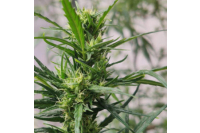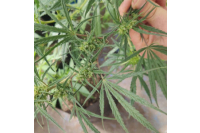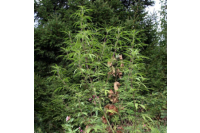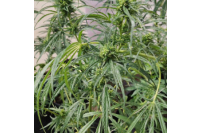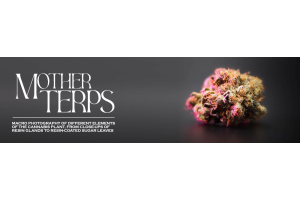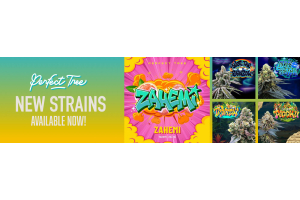Strain Diaries: South Africa

What is a Land Race?
Beginning our series on Landrace and indigenous cannabis strains, we start with South Africa, home to some of the most notorious and celebrated landrace strains. Africa is a critical location in the history of cannabis, with a rich history of indigenous cannabis strains. Even today some of the most desirable modern genetics, such as Girl Scout Cookies, have been influenced by landrace strains in their recent genetic lineage, such as Durban Poison. We've decided to focus our series around these landrace strains as they are types of cannabis genetics whose genes have remained pure and untampered with for around 1000 years, indigenous to the regions in which they reside. Landrace cultivars are increasingly becoming sought after in recent years due to their distinctive and consistent characteristics, which often leads to a novel smoking experience for even some of the seemingly most well-versed cannabis connoisseurs.
Countless researchers and authors have reported that humans have been using cannabis for at least 1200 years. Still, some reports have indicated evidence of cannabis consumption as early as many thousands of years B.C. Many of these researchers believe that cannabis originated in Central Asia in the regions now known as Mongolia and Southern Siberian regions. It is theorised that the movement of the various traders across these regions, such as via the infamous silk road trade route, has allowed ancient stoners to spread seeds far and wide across multiple locations across the globe. These strains of cannabis have then adapted to their new environment and the unique geographic characteristics found within them.
As popular culture has begun to embrace Cannabis with open arms and governments remove some of the restrictions surrounding Cannabis, the hybridisation of modern genetics has changed the reality of Cannabis. The hybridisation of Cannabis alongside a dramatic shift in the environment cannabis is grown in, such as moving to indoor grows from mountainous outdoor regions, has forever changed the dynamic of the modern Cannabis landscape.
Sadly in the present day, most of the Landrace strains are threatened with the risk of extinction, unlike the vast majority of plants: research studying the development, linage and history is limited. Furthermore, even landrace strains still growing in their natural habitat are at risk of being lost, thanks to the introduction of modern genetics into the region, resulting in the pollination of the landrace strains. Moreover, in many locations where landrace cannabis strains are cultivated in mass, the Cannabis farms are often restricted to mountainous regions, where, often sweeping valleys allows the wind to cut through and carry live pollen countless miles, which usually ends in the landraces being pollinated by new genetics. Consequently, if this pollen comes from modern hybrid genetics, then this can contaminate and dilute the gene pool found in the region.
Durban Poison
One of the landrace cultivars that South Africa is best known for is Durban Poison. Durban Poison was first made known to the world in the mid-70s by High Times columnist and cannabis activist Ed Rosenthal when he travelled to South Africa to identify and locate new cannabis cultivars. In the eastern seaside city of Durban, he first heard about a cultivar with what was at the time an incredibly speedy flowering time of 60 days. Rosenthal managed to secure some seeds from Durban, which became known as Durban Poison seeds. Ed Rosenthal shared these seeds with Mel Frank, a botanist who then passed the progeny over to the infamous Sam the Skunkman, an Amsterdam-based cannabis cultivator and hashish enthusiastic who is the first known proponent of Static Tech for isolating 99.9% pure THC heads.
Durban Poison is one of the most notorious of South African cannabis genetics and has gained a reputation thanks to its soaring cerebral effects; it is often called a Pure Sativa strain (making it an excellent choice for the first edition of our strain diaries) but is now more accurately described as being a narrow leaf variety of Cannabis. Durban Poison has a luscious sweet pine and citrus terpene profile primarily dominated by the D-Limonene terp, which is to thank for the potent citrus flavour. Durban Poison grows with a rounded and chunky bud structure coated in a thick coating of trichomes; the resin glands it's covered in are above the average size. Durban Poison grows with a distinctive appearance, towering tall & will turn slightly purple in late flower. The THC levels were remarkably high during the era in which it was brought back to Amsterdam, at 15-24% and just 0.02% CBD; these ranges are quite normal with modern hybrids but was sure to be a potent strain for consumers back then. As a result, it's frequently believed that it's a great antidote to Nausea, pain, migraines, stress, depression or simply some lethargy, so much so that it's called the 'espresso of weed'. Durban Poison's effects are widely reported to be highly potent and long-lasting, leaving you floating through your day afterwards. The flavour is both fragrant, woody and citrusy, creating a complex but balanced flavour & it is well known for its resistance to pests and drought, likely an example of natural selection required by the intense climates in Durban. Ed Rosenthal has reported that there are two main phenotypes of Durban Poison, the red pheno and the green pheno. The Green pheno had a longer growing time.
In contrast, the red pheno (which is the one that has become popular thanks to Mel Frank and Ed Rosenthal), who brought it back and worked with it to cross it with either Skunk varieties, Northern Lights or Hindu Kush to speed up the flowering time as well as increasing the yield. Hopefully, the green pheno is still out there, waiting to be protected and worked with. Durban Poison has been potentially linked back to the 14th century when the Khoikhoi and San tribes cultivated south African landraces.
KwaZulu Landrace?
One of the other most well-referenced strains from South Africa is the KwaZulu strain. The Strain was frequently found in the KwaZulu Natal region in South Africa, close to the Indian Ocean coast; it is the home of the Zulu's native warrior tribe. According to local legend, this cannabis plant was a present from the Gods to the local community. KwaZulu's been reported to be grown initially by generations of the Shaka Zulus, who at one point were one of the most prominent farmer warrior tribes in the region. It is even referenced that it was a critical component when used in battle preparations to fend off British attackers as far back as 1879. It is also reported to be another Pure Sativa variety that in the wild grows to the northside of the Drakensberg ridge, flowering early with a sweet taste and energising effect. KwaZulu is also known to be incredibly resistant to pests and mildew, which is sure to be an attribute the strain has developed from Natural Selection. Over the years, some individuals have speculated whether the KwaZulu 'Landrace' could really be Durban Poison thanks to its proximity to the city of Durban and the strain's similar growing attributes. Still, there are likely countless strains that went through Durban as it was an essential port for travel of goods in and out of South Africa, and environmental factors might be similar to close to the Durban region so this might simply be a coincidence.
Strain Hunters Eastern Cape Expedition 10
Strain Hunters can be credited with bringing landrace awareness to the general public for well over a decade through popular T.V. institutions. The Strain Hunters sole purpose is to discover and recover cannabis landrace strains that haven't been studied yet by scientists or doctors; this allows them to retrieve these genetics to enhance further knowledge of the cannabis plant in the medicinal fields. Strain Hunters was helmed by Arjan Roskam and Franco Loja from the legendary Greenhouse coffeeshop in Amsterdam until Loja tragically caught malaria, leading to his untimely death.
Strain Hunters stand in distinct parallel to the modernity of Cannabis, as Cannabis is rife in today's time; but Cannabis strains untainted by the modern world are what the Strain Hunters seek. The ability to take part in what is both a unique cannabis experience and a tradition that dates back to the early days of civilisation is sure to be part of the allure of landrace strains in modern times. Through the Strain Hunters team saving these strains and bringing back untainted cannabis, varieties they can enrich the current cannabis landscape.
The Strain Hunters team recently returned to South Africa 5 years after the death of Loja; the team returned to the home of the AmaMpondo people in the Eastern Cape province of South Africa. Seeing the varieties available in the Eastern Cape province of South Africa, in the area previously known as the Transkei region, we were influenced to write about the South African region. Arjan from Strain Hunters puts it simply that these farmers who work exceptionally hard to grow and maintain unique landrace genetics should be protected & this is something that we absolutely stand behind. Unfortunately, this isn't usually the case when the government is involved, and in the Transkei region, the South African government has been attempting to poison the landraces, so they are destroyed; in fact, it should be noted that environmental permission has never been given to use toxins at the scale that the South African government have been using, so who knows how severe the impact will be on the region or the community of AmaMpondo people.
In the latest episode of Strain Hunters, they were once again on the hunt to discover & preserve landrace genetics after a 5-year hiatus since Loja's death. The first cannabis variety they found as they travelled down the Umzimvubu river had a unique terpene profile that they likened to fresh carrots. In this first location, even the male plants are said to have an intense distinctive aroma, immediately indicating the strength of these genetics. As the team travelled further down the Umzimvubu river, better-preserved genetics appeared, showing fewer signs of in or outbreeding, which has become an issue in many places where Cannabis grows wildly as the desire for the latest and greatest stretches far and wide. The second farm that Strain Hunters found has masses of plants growing with a less Sativa leaning appearance and more of a zingy lemon terpene profile; some of these strains were described as emitting more of a potent lime smell, but all had a healthy coating of resin glands.
At the third outdoor farm they visited, they found had a wide array of different strains available here; strains with a typical Sativa like structure alongside an overly sweet candy-like lemon scent. They also discovered some purer landrace strains in this area that expressed brown hues and exhibited a rich skunky aroma, which grew to quite a short height. The most dominant expressions in this farm are a bright green, a super sweet vanilla strain that grows larger than the neighbouring genetics. The strains here were showing fewer signs of inbreeding or outbreeding. The further down this remote river, the more agricultural fields they discover, and at one point, they found that there were one every 500 meters down the river. At this point, the landraces are uniform, and the team report that it is easy to tell that these genetics are far purer and consist of ancient genetics. The further down you go, the more stable they are & in these remote locations, they found a super spindly and towering Sativa strain with a structure very close to the Dr. Grinspoon strain; the buds are minuscule on this Strain. Steven from the team postulated that perhaps this Strain is the ultimate survivor, and the buds are so tiny they don't really make up a typical bud structure, but every single calyx has seeds indicating that this has adapted to grow in these extreme climates and keep producing new cannabis growth. Finally, they found the best yielding Strain at this fourth location with a seriously intense carrot aroma that appeared to be the most exciting find to the team so far.
Stay tuned for our next strain diary blog where we will be continuing this series looking at strains found in various locations around the globe!

